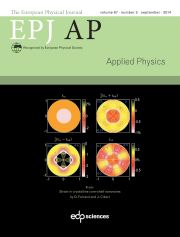Article contents
Mode-locking characteristics and relative intensity noise reduction in hybrid soliton pulse source
Published online by Cambridge University Press: 21 January 2004
Abstract
The noise and mode-locking phenomena of a hybrid soliton pulse source (HSPS) utilizing different fiber Bragg gratings (FBG) with or without linear chirp are described. The HSPS is modeled by a time-domain solution of the coupled-mode equations including spontaneous emission noise, and relative intensity noise (RIN) is calculated using numerical solutions of these equations. It is found that transform-limited pulses over a wide tuning range around the fundamental mode-locking frequency are generated from mode-locked HSPS with linearly chirped uniform and Gaussian apodized FBGs. Mode-locked pulses that are not transform-limited are generated over a wide tuning range from HSPS with Gaussian apodized and uniform FBGs. These gratings can give transform-limited pulses only over a limited tuning range around the fundamental mode-locking frequency. It is also found that RIN reduction is possible for the mode-locked HSPS by selecting a suitable apodization function such as Gaussian and linear chirp rate.
- Type
- Research Article
- Information
- Copyright
- © EDP Sciences, 2004
References
- 7
- Cited by


